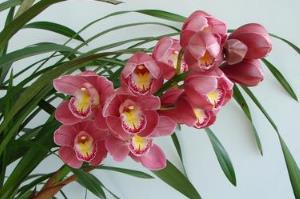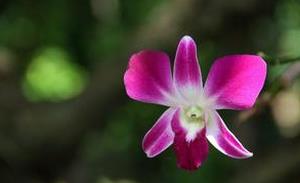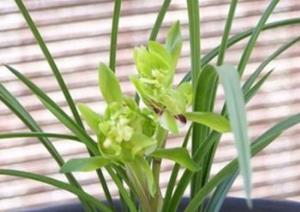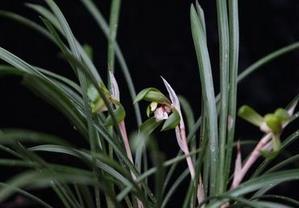What about the yellow leaves of orchids? what is the reason why the leaves become dry?
Orchids have always been one of the most favored flowers for flower lovers, but when many flower lovers raise orchids, they will encounter orchids that are well raised at home and the leaves will turn yellow somehow, so they are very distressed. So now
First, what if the leaves of orchids turn yellow?

First, the water is yellow. Due to excessive watering, it is characterized by no obvious change in the old leaves and yellowing of the young leaves, which should be controlled immediately.
Second, dry and yellow. Due to lack of water and drought, it is characterized by the yellow of the old leaves from the bottom to the top. If the lack of water is a little longer, the yellow leaves of the whole plant, or even death, should be watered in time.
Third, fat yellow. It is caused by excessive fertilization or high concentration, which is characterized by thick, shiny and uneven young leaves; fertilizer, ploughing and watering should be controlled.
Fourth, hungry yellow. It is caused by insufficient fertilizer, low fertilization concentration, and long fertilization interval, which is characterized by yellow young leaves and tender stems. If you do not apply fertilizer in time after seeing this phenomenon, it will also cause yellow leaves and even death of the whole plant. For flowers lacking fertilizer, do not apply a large amount of thick fertilizer at one time, so as not to cause root burning.

Fifth, iron deficiency yellow leaves. Due to the great change of soil fertility conditions, the phenomenon of yellow leaves often occurs in woody flowers in greenhouse, which is characterized by obvious young leaves, light old leaves, yellow mesophyll and green veins, and forms a typical network, which can be solved by using ferrous sulfate solution. The method is as follows: 7 parts of cake fertilizer, 5 parts of ferrous sulfate and 200 parts of water.
Sixth, lack of elements and loss of green. If there is a lack of iron in the basin soil, the top of the leaf turns yellow first. If there is a lack of nitrogen, the new leaves are yellowish white.
Sunburn. Strong direct sunlight, especially after summer, leaves have macula, known as sunburn disease. When the high temperature is above 30 degrees, the leaves are also easy to yellowing.
8. Pollution. Orchid leaves should be kept clean. If splashed with dirt, the contaminated area may turn yellow.
9. Freezing injury. When the orchid is below 0 degrees, freezing injury occurs, and the symptom is still yellow leaves.

Sunburn. Magnolia is a negative plant, in the hot sun exposure, the leaves will dry up, even in the high temperature room is also easy to burn out. The solution is to avoid exposure to the sun, regularly wipe the leaves with beer with a rag, and the gentleman orchid scrubbed with beer is not only good-looking but also not easy to lose the moisture of the leaves.
11. Leaf spot. The disease is caused by bacterial infection, which is mainly caused by the change of unmature raw soil, the application of unfermented fertilizer, the long-term failure of basin soil, the imbalance of fertilizer nitrogen, phosphorus and potassium, and the excessive amount of fertilizer. In the early stage of the disease, small yellow-brown spots appeared on the leaves, and then the color of the spots gradually deepened, and the area of the spots continued to expand, resulting in festering, so that the whole plant rotted away.
Solution: the placement of flowers should be ventilated to overcome the direct sunlight. Orchids often experience leaf tip dryness, or even whole leaf wilt. Flower friends who raise orchids for the first time do not know what to do. Orchid leaf tip dryness is mainly caused by orchid anthracnose and round spot disease. When orchids suffer frost damage or late frost, it is also easy to form leaf tip dryness or discoloration. Let's take a look at the specific solutions.
Caused by orchid anthracnose and round spot. The disease occurs in large numbers during the rainy season or when it is hot and rainy at the turn of summer and autumn. The solution is to spray 50% carbendazim or 50% grams of carbendazim 1000 times in the disease-prone period, once every 10 days, for 4 times.

Second, what is the reason why the leaves of orchids become dry?
1, the basin is too dry or the air humidity is too small, the basin surface is too dry, this kind of situation generally the orchid leaf shrinks the head cannot show immediately, the first reflection is the orchid leaf presents the dehydration shape, after waiting for the watering recovery, it is easy to walk the grass from the old seedling, the orchid leaf starts from above to down the yellow leaf, if the basin water injury, the orchid leaf turns yellow, is from the bottom to up the yellow leaf, the grass walking time is slow.
2. Langen fungus damage or Langen crystal head affected by water stain should be the same, water stain is a process, crystal head rot is the result, leaf tip coke head is a surface phenomenon. Such a coke tip, as Fei Xiang said, the leaf tip is black, after the treatment in the basin, the general coke head is no longer extended.
3. The focal point is caused by fertilizer damage, and the focal tip is brown or black. The boundary with the non-fat damage orchid leaf is very obvious, and the normal tissue of the orchid leaf is also prone to fat spots, such irregular round spots, the center of the spot is brown, and the place where it comes into contact with the normal tissue is a circle of black spots with uneven thickness, and the boundary is also very obvious.

4. Many of the bacteria damage caused by the orchid strain are shown from the coke tip phenomenon. For example, the blight tip is white-brown, the junction with the normal blue leaf tissue is dark brown, the white brown is the dead dry withered area, the black brown is the fungus outbreak area; the leaf blight, the leaf tip light brown is the dead dry withered area, the dark brown is the fungus damage outbreak area, and most of the contact areas with normal blue leaf tissue are yellowish green, this yellow-green area is the infection area of normal orchid leaf tissue, which is different from the blight tip disease. Anthracnose is also easy to show the focal tip, the leaf tip shows a dark brown, a light brown, alternately to the lower part of the blue leaf, and independent or connected dark-brown patches appear in the leaves, and the periphery of the plaque is yellowish.
Solution: when orchids suffer from frost injury or late frost, it is also easy to form leaf tip drying or discoloration. Therefore, in areas where the winter temperature is below 0 ℃, orchids should be moved to indoor ventilation and sunny places for maintenance before winter. When you move outside in spring, you should pay attention to avoid the harm of late frost. Traditional spring is not windy, summer is not day, autumn is not dry, winter is not wet to prevent orchid leaves from drying up.
For the orchid leaves that have been withered at the tip, if the situation is not too serious, the method of manual cutting can be used, with scissors, preferably by alcohol disinfection. Cut off about 10 mm below the dry part, so that you can still keep the basin full of green. It would be better if you spray fungicide after pruning.

Potted orchids often have leaf tip withering, or even whole leaf wilt, which is mainly caused by orchid anthracnose and round spot. This disease occurs in large numbers in the rainy season or at the turn of summer and autumn when it is hot and rainy. 50% carbendazim 1000 times or 50% grams of carbendazim can be sprayed once every 10 days for prevention. Families can buy small packages of sterilized pesticides. In addition, when orchids suffer from frost injury or late frost, it is also easy to form leaf tip drying or discoloration. Therefore, in areas where the winter temperature is below 0 degrees, the orchids should be moved to indoor ventilated and sunny places for maintenance before winter. The orchid leaves that have been withered at the tip of the leaf can also be cut off manually when it is not too serious. With scissors, it is best to press A-shaped by alcohol disinfection to cut off about 10 millimeters of the base below the dry part, which can still be kept full of green.
The line is also very clear.

4. Many of the bacteria damage caused by the orchid strain are shown from the coke tip phenomenon. For example, the blight tip is white-brown, the junction with the normal blue leaf tissue is dark brown, the white brown is the dead dry withered area, the black brown is the fungus outbreak area; the leaf blight, the leaf tip light brown is the dead dry withered area, the dark brown is the fungus damage outbreak area, and most of the contact areas with normal blue leaf tissue are yellowish green, this yellow-green area is the infection area of normal orchid leaf tissue, which is different from the blight tip disease. Anthracnose is also easy to show the focal tip, the leaf tip shows a dark brown, a light brown, alternately to the lower part of the blue leaf, and independent or connected dark-brown patches appear in the leaves, and the periphery of the plaque is yellowish.
Solution: when orchids suffer from frost injury or late frost, it is also easy to form leaf tip drying or discoloration. Therefore, in areas where the winter temperature is below 0 ℃, orchids should be moved to indoor ventilation and sunny places for maintenance before winter. When you move outside in spring, you should pay attention to avoid the harm of late frost. Traditional spring is not windy, summer is not day, autumn is not dry, winter is not wet to prevent orchid leaves from drying up.
For the orchid leaves that have been withered at the tip, if the situation is not too serious, the method of manual cutting can be used, with scissors, preferably by alcohol disinfection. Cut off about 10 mm below the dry part, so that you can still keep the basin full of green. It would be better if you spray fungicide after pruning.

Potted orchids often have leaf tip withering, or even whole leaf wilt, which is mainly caused by orchid anthracnose and round spot. This disease occurs in large numbers in the rainy season or at the turn of summer and autumn when it is hot and rainy. 50% carbendazim 1000 times or 50% grams of carbendazim can be sprayed once every 10 days for prevention. Families can buy small packages of sterilized pesticides. In addition, when orchids suffer from frost injury or late frost, it is also easy to form leaf tip drying or discoloration. Therefore, in areas where the winter temperature is below 0 degrees, the orchids should be moved to indoor ventilated and sunny places for maintenance before winter. The orchid leaves that have been withered at the tip of the leaf can also be cut off manually when it is not too serious. With scissors, it is best to press A-shaped by alcohol disinfection to cut off about 10 millimeters of the base below the dry part, which can still be kept full of green.
Related
- Wuhan Hospital Iron Tree Blooming Result Was Instantly Frightened by the Gardener Master
- Which variety of camellia is the most fragrant and best? Which one do you like best?
- What is the small blue coat, the breeding methods and matters needing attention of the succulent plant
- Dormancy time and maintenance management of succulent plants during dormancy
- Minas succulent how to raise, Minas succulent plant pictures
- What are the varieties of winter succulent plants
- How to raise succulent plants in twelve rolls? let's take a look at some experience of breeding twelve rolls.
- Attention should be paid to water control for succulent plants during dormant period (winter and summer)
- Watering experience of twelve rolls of succulent plants
- Techniques for fertilizing succulent plants. An article will let you know how to fertilize succulent plants.



